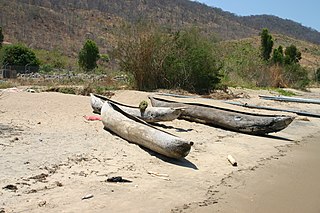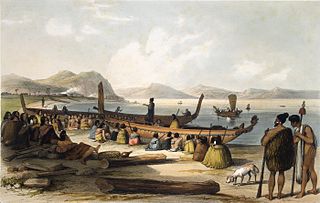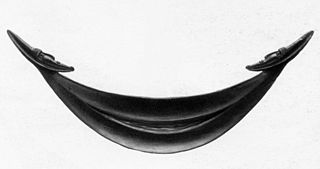
Binabina or biabina is a type of plank boat from the Solomon Islands. It differs from the similar tomako and lisi in that only the stern is upturned, while the bow is horizontal. [1] [2]

Binabina or biabina is a type of plank boat from the Solomon Islands. It differs from the similar tomako and lisi in that only the stern is upturned, while the bow is horizontal. [1] [2]

A dugout canoe or simply dugout is a boat made from a hollowed tree. Other names for this type of boat are logboat and monoxylon. Monoxylon (μονόξυλον) is Greek -- mono- (single) + ξύλον xylon (tree) -- and is mostly used in classic Greek texts. In German, they are called Einbaum. Some, but not all, pirogues are also constructed in this manner.

Kolombangara is an island in the New Georgia Islands group of the nation state of Solomon Islands in the southwestern Pacific Ocean. The name is from a local language, a rough translation of its meaning is "Water Lord" with approximately 80 rivers and streams running down its flanks.

Waka are Māori watercraft, usually canoes ranging in size from small, unornamented canoes used for fishing and river travel to large, decorated war canoes up to 40 metres (130 ft) long.

A tepukei, tepuke or TePuke is a Polynesian boat type, characterized by its elaborate decking, its submerged hulls and symmetrical "crab claw" sail slender foil or radically extended tips claw sail. Tepukei boats are produced primarily by the Polynesian-speaking inhabitants of Taumako, and have been occasionally borrowed by other Polynesian and Melanesian societies.

The British Solomon Islands Protectorate was first declared over the southern Solomons in 1893, when Captain Gibson, R.N., of HMS Curacoa, declared the southern islands a British protectorate. Other islands were subsequently declared to form part of the Protectorate.

Rendova is an island in the Western Province of the Solomon Islands in the South Pacific, east of Papua New Guinea.

A war canoe is a watercraft of the canoe type designed and outfitted for warfare, and which is found in various forms in many world cultures. In modern times, such designs have become adapted as a sport, and "war canoe" can mean a type of flatwater racing canoe.
Arthur Reginald "Reg" Evans, DSC was an Australian coastwatcher in the Pacific Ocean theatre in World War II. He is chiefly remembered for having played a significant part in the rescue of future US President John F. Kennedy and his surviving crew after their motor torpedo boat, PT-109, was sunk by the Japanese in August 1943.
Biuku Gasa and Eroni Kumana were Solomon Islanders of Melanesian descent, who found John F. Kennedy and his surviving PT-109 crew following the boat's collision with the Japanese destroyer Amagiri near Plum Pudding Island on 1 August 1943. They were from the Western Province of the Solomon Islands.

A reimiro is a crescent-shaped pectoral ornament once worn by the people of Easter Island. The name comes from the Rapanui rei and miro ('boat'). Thus the crescent represents a Polynesian canoe.

Laulasi island is an artificial island in the Langa Langa Lagoon, South of Auki on the island of Malaita in the Solomon Islands. It is believed that hostilities among the inlanders of Malaita forced some people into the lagoon where over time they built their islands on sandbars after diving for coral. The religion of the island was based on prayers and offerings to the ghosts of dead ancestors, mediated by priests who kept their skulls and relics in tabu houses. Some ancestors were incarnated as sharks which protected their descendants. Langalanga is also the main source of the shell money now made in Solomon Islands.

Langa Langa Lagoon or Akwalaafu is a natural lagoon on the West coast of Malaita near the provincial capital Auki within the Solomon Islands. The lagoon is 21 km in length and just under 1 km wide. The "lagoon people" or "salt water people" live on small artificial islands built up on sand bars over time where they were forced to flee from the headhunters of mainland Malaita.
James Wharram was a British multihull pioneer and designer of catamarans.

Salisipan are long and narrow war canoes, with or without outriggers, of the Iranun and Banguingui people of the Philippines. They were mainly used for piracy and for raids on coastal areas. Salisipan resemble a long and narrow bangka that sit low on the water. They are propelled by rowers, steered by an oar at the stern, and are light enough to be hauled ashore. They are typically equipped with woven shields of nipa that could be propped along the sides to protect the rowers against arrows. They are sometimes also known by the more general terms vinta, baroto, or kakap. Salisipan are auxiliary vessels that accompany larger motherships like pangajava, garay, and lanong. Their presence was usually indicative of a larger raiding fleet nearby.
The Kalikoqu is a tribe in the Roviana Lagoon, on the southern side of New Georgia in the Solomon Islands. Currently, in the Roviana Lagoon, the larger tribal polities are the chief districts of Saikile and Kalikoqu.

Tomako or tomoko is a large war canoe from the Solomon Islands. The name "tomako" is used in New Georgia in the Roviana language. It is also known as magoru in Marovo, niabara in Vella Lavella, mon in Bougainville, ora in Makira, and iola or ola in Malaita and Ulawa. Tomako were narrow and usually between 12 to 18 m in length. They did not possess outriggers or sails and were propelled solely by paddling. They were built by fitting planks edge-to-edge which are then "sewn" together and caulked with a paste made from the nut of the tree Parinarium laurinum. They could carry 30 to 50 warriors, and were used in raiding expeditions for slaves or for headhunting. They were characteristically crescent-shaped, with sharply upturned prows and sterns that were decorated with fringes of cowrie shells, nautilus shells, and mother-of-pearl, as well as intricate carvings. These carvings are usually of spirit animals or warriors like the kesoko and Tiolo. The body is commonly blackened to contrast with the decorations.
Lisi is a type of plank boat from the Solomon Islands. It is crescent-shaped and is similar in appearance to the tomako war canoes, but differs in that the topmost strakes of the lisi have a gap in the middle. Lisi are also usually proportionally broader and less ornamented than the tomako. They are used for fishing and transport rather than for raiding. Lisi can vary in size from small canoes to large ships used for trade. The largest types of lisi are known as solima, which can carry 50 people and is used for long sea voyages. There are two general types of lisi, the ordinary trading lisi is known as the "lisi nume." An ornate lisi with inlaid shell decorations used for transporting village chiefs in diplomatic missions is known as the "la'o." Voyages of lisi to other islands usually required a ritual human sacrifice on the return trip known as siki po'upo'u.
Olasana Island is a small uninhabited island in the New Georgia Islands of the Western Province of the Solomon Islands. The island is primarily notable for its role in the events after the sinking of PT-109 involving future American president John F. Kennedy.

The Solomon Islands National Museum is the national museum of the Solomon Islands and is located in Honiara. It is a department of the Ministry of Culture and Tourism.

Ipanitika, also known as chinedkulan, are traditional fishing boats of the Tao people of Orchid Island, Taiwan. They are around 7.6 m (25 ft) and can carry up to 10 to 14 people. Smaller versions of the ipanitika is known as the tatara or tatala, which are around 2.3 m (7.5 ft) long and can carry at least 2 people. They were propelled by oars mounted on a row of rope-wrapped posts that are slotted into a shelf built into the hull of the boat.